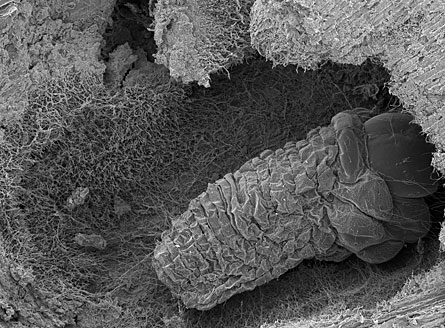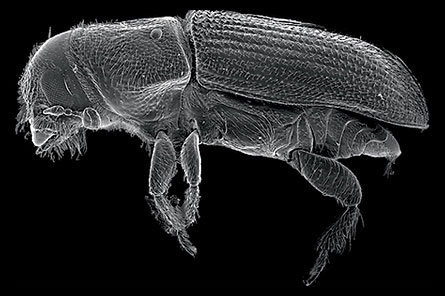Southern pine beetles get by with a little help from their friends, including a newly discovered bacterium that makes a weed killer.


When the beetles burrow into trees to lay eggs, they leave behind spores that sprout into a garden of fungal baby food. Now electron microscopy, beetle sampling and lab tests suggest that the female beetles also mix in helpful strains of bacteria, says Jarrod Scott of the University of Wisconsin–Madison.
The bacteria secrete a previously unknown small molecule that discourages weedy fungi from crowding out the garden, Scott and his colleagues report in the Oct. 3 Science.
The new substance itself may not be useful to people, but Scott describes the finding as possible inspiration for prospecting chemists. “We think that symbiotic associations between insects and microbes could be an untapped source for novel compounds for antimicrobials,” he says.
Relying on live-in bacterial pals to protect a mutualist partner could turn out to be a widespread strategy among insects, Scott says. Coauthor Cameron Currie, also at Wisconsin–Madison, had previously discovered bacterial weed killers among certain ants that tend vast underground gardens of fungi.
Understanding the ways of southern pine beetles is particularly important because they have done some $100 million a year in damage to trees since the 1960s, says USDA Forest Service entomologist John T. Nowak. Based at the Forest Health Protection field office in Asheville, N.C., Nowak battles the beetles, which kill trees and leave lumber tinted a potentially off-putting blue from hitchhiking fungi. For the pine forests of the Southeast, the beetle has “always been our number one issue,” he says.
Southern pine beetles (Dendroctonus frontalis), it turns out, live within a web of mutualisms. As a female burrows into a tree, she carries specialized fungi protected in a structure under her chin. “You can almost imagine it like a dog collar,” Scott says. The Entomocorticium fungi grow into a lawn where the young beetles graze. Without the fungi, the larvae falter and die.
There’s a dueling mutualism though. Various mites hitchhike on adult beetles and bring along their own fungi for food. Earlier tests showed that one mite fungus, Ophiostoma minus, was mightier than the beetle’s fungus and could crowd it out. And young beetles can’t live on the mite fungus.
Sampling the beetles’ fungi-carrying structures, though, revealed a form of a bacterium in the Streptomyces genus. In face-offs set up in the lab, the bacteria inhibited the mite fungus but let the beetle’s fungal garden grow.
What gives the bacterial secretion its bite is an antifungal agent the researchers are calling mycangimycin, says coauthor Jon Clardy at HarvardMedicalSchool in Boston. He describes it as a polyunsaturated fatty acid carrying a peroxide group, which he suspects gives it its punch.
“It’s a touchy molecule,” he says. So unstable that it won’t be commercially useful, but it could still yield valuable information. “I have little hope for the molecule,” he says. “What I do hope is that it will teach us new targets for antifungals.”






